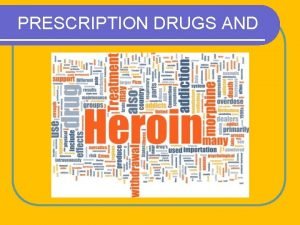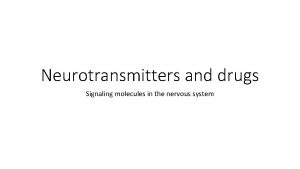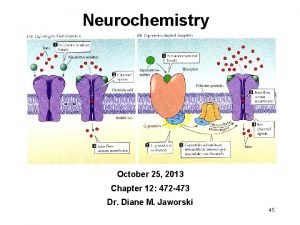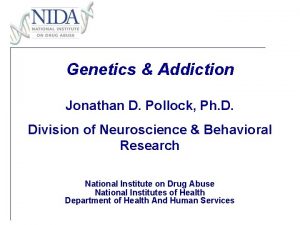Genetics Addiction Jonathan D Pollock Ph D Division

















- Slides: 17

Genetics & Addiction Jonathan D. Pollock, Ph. D. Division of Neuroscience & Behavioral Research National Institute on Drug Abuse National Institutes of Health Department of Health And Human Services

NIDA’S GENETICS PROGRAM • Extramural Program: –Genetic Epidemiology –Twin Studies –Adoption studies –Molecular Genetic Studies – Model Genetic Organisms –Mice –C. elegans –Zebra fish –Drosophila • Intramural Research Program (NIDA-IRP)

Addiction is a Heritable Disorder • Evidence: – Twin Studies – Adoption Studies – Inbred Rodent Strains

Addiction is a Heritable Disorder: Twin Studies

Addiction is a Heritable Disorder: Inbred Strains of Rodents • Genetic Basis to Preference for Drugs of Abuse – Example: Morphine preference mapped: – Chromosome 1, 6, 10 in mice – Linkage on chromosome 10 maps to mu opioid receptor

Research Designs for Human Genetic Studies • Possible designs: – heritability estimates – genome wide scans – candidate gene studies • Types of studies: – sib pairs – family studies – association studies

Genes Implicated in Addiction Candidate Genes • Genes are part of addiction vulnerability: – – Initiation (limited genetic influence? ) Dependence Withdrawal Medical Consequences • Some specific genes have been implicated in addiction

Genes Implicated in Addiction • Variants of genes associated with drug abuse: – FAAH missense mutation is associated with drug dependence – Dopamine beta-hydroxylase (DBH) – cocaine-induced paranoia – Polymorphism in promoter region of prodynorphin gene may be associated with protection against cocaine dependence – Gene variants in nicotinic alpha 7 promoter associated with decreased expression of nicotinic alpha 7 subunit message in different regions of schizophrenic brains and with sensory gating defects in schizophrenics – 5 HT 1 B receptor variant is associated with conduct disorder and Alcoholism

Genes Affecting Drug metabolism ADH 2 ADH 3 ALDH 2 ALDH 3 • Ethanol Acetaldehyde Acetate -Individuals with defects in this metabolism pathway have a 5 -10 -fold reduction in risk for alcoholism CYP 2 A 6 • Nicotine Cotinine - Individuals with defects in this metabolism pathway appear to smoke fewer cigarettes

SNP Genome Wide Association Scan and Polydrug Abuse

Extramural Program: Human Molecular Genetics • NIDA Genetics Consortium –established 1999 – 17 researchers from 11 different institutions • Studies focusing on addiction to: – – Opiates Cocaine Nicotine Poly drug abuse

The NIDA Center for Genetic Studies • The NIDA Center for Genetic Studies - Data/biosample repository - The repository uses the blood samples to generate immortalized cell lines, as a permanent source of DNA - The anonymized data are stored in a central Database -Has the advantage of pooling data increase power and facilitate sharing

Molecular phenotyping: genes patterns • Every human cell has approximately 30, 000 genes, some turned on and some turned off I the addicted state • Microarray technology can simultaneously analyze activity of thousands of genes, and thereby provide an overall pattern of gene expression for dug addiction

Gene Expression by Microarray Profiling Low level High level NORMAL CONTROL Walker, Feinberg & Self, 2000, unpublished COCAINE WITHDRAWAL

Mouse Knockouts: Finding Drug Targets for Treatment of. Drug Abuse – DAT/SERT Knockout • Conditioned place preference to cocaine is blocked – m. Glu. R 5 -receptor Knockout • Mice do not self administer cocaine – Muscarinic M 5 receptor deletion • Mice show no preference for opioids – Alpha 1 b adrenergic receptor knockout • Oral self-administration of cocaine and morphine decreased – Substance P receptor knockout • Rewarding effects of opiates but not cocaine are absent – Cannabinoid CB 1 receptor knockout • Self-administer cocaine but not morphine

Genetic Organisms are Uncovering Mechanisms of Action of Drugs of Abuse • Tolerance: – Beta-Arrestin • Details • Withdrawal – CREB • Details • Addiction – Delta-fos. B • Details

Why do Genes Matter • Better understanding of environmental factors in addiction • Will improve treatment interventions • Facilitate understanding the neurobiology of addiction and drug abuse
 Joni rutter
Joni rutter Jonathan d. pollock
Jonathan d. pollock Learn.genetics.utah/content/addiction/mouse
Learn.genetics.utah/content/addiction/mouse Http://learn.genetics.utah.edu/content/addiction/
Http://learn.genetics.utah.edu/content/addiction/ Http://learn.genetics.utah.edu/content/addiction/
Http://learn.genetics.utah.edu/content/addiction/ Summertime jackson pollock
Summertime jackson pollock Pollock
Pollock Untitled (blue green and brown)
Untitled (blue green and brown) Elex searching for clues
Elex searching for clues Sara meda
Sara meda Jackson pollock untitled 1948
Jackson pollock untitled 1948 Pali blu di pollock
Pali blu di pollock Dv
Dv Nomogram for percent body fat
Nomogram for percent body fat Lauren pollock
Lauren pollock Jakcson pollock
Jakcson pollock Dorothea lange jackson pollock
Dorothea lange jackson pollock Jane pollock
Jane pollock
































